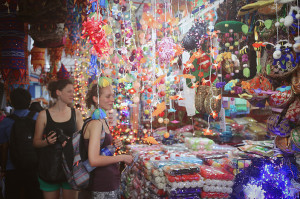New Little India Heritage Trail Refreshes Trail Experience With Enhanced Features
The annual Deepavali bazaar at Little India. Picture taken from www.littleindia.com.sg
Few would know that Little India, unlike its sister precincts of Chinatown and Kampong Gelam, was never intended by Sir Stamford Raffles to be an area designated for Singapore’s Indian community. Instead, it developed its identity organically over the years, establishing itself as a melting pot of diverse communities and cultures. These types of lesser-known facts of Little India will be made available and accessible to Singaporeans and visitors through the Little India Heritage Trail, the newest heritage trail by the National Heritage Board (NHB).
The Little India Heritage Trail is NHB’s 16th heritage trail. It features over 40 heritage sites with 18 heritage markers across four kilometres, detailing the history of the over 200- year-old precinct. Aside from the staple heritage trail offerings of heritage markers, a trail brochure, and maps in four languages (English, Mandarin, Malay and Tamil), all of which illustrate the history and heritage of selected sites, the Little India Heritage Trail goes the extra mile with specially curated thematic routes to cater to time-crunched trail-goers. The three bite-sized thematic routes are:
- Serangoon in the 1900s (40 minutes)
This route takes trail-goers on a historical trail to learn about the early communities that settled in the area in the early 20th century. - Walk of Faiths (1 hour)
This route features the many different places of worship on the Little India Heritage Trail, and provides insights into the different religions and communities that have co-existed in the precinct since the early days. - Shop Till You Drop (30 minutes)
This route allows trail-goers to enjoy the myriad of retail offerings in Little India, while learning more about the traditional businesses in the district.
Another new offering, to be launched later this year, uses Bluetooth beacons installed on the heritage markers along the trail. Through visitors’ mobile devices, these beacons will enable them to explore the history and stories around each marker in greater detail.
Trail-goers will be able to access lesser known information of the site they are at, and view photos of the site shared by other trail-goers. This new trail function also helps users identify the other heritage markers close by, and features simple directions to help them get to their next destination.
Mr Alvin Tan, Assistant Chief Executive (Policy and Community) of NHB, said, “We are always looking to improve the experiential aspects of our museums, festivals and heritage trails. These improvements will enable users to enjoy trail content that has been customised to appeal to more specific interests as well as to retrieve additional trail content with greater ease. We will continue to collect feedback from users of our heritage trails, review our trail offerings and incorporate the necessary enhancements for our future trails.”
Community Giving Back Through Heritage
To encourage greater interest and involvement by youths in our history and heritage, NHB will be working closely with the Nanyang Academy of Fine Arts (NAFA) and Umar Pulavar Tamil Language Centre (UPTLC) – one of MOE’s Language Centres – to adopt the Little India Heritage Trail for a period of three years. This an initiative under NHB’s signature Heritage Trail Adoption Scheme will see teachers and students incorporating the heritage trails and their rich content into the school curriculum. Upon completion of their training, the students from NAFA and UPTLC will be guiding their peers on the Little India Heritage Trail as trail guides. NHB and the Indian Heritage Centre (IHC) will also be offering guided tours for the Little Heritage Trail in the coming months.
The Little India Heritage Trail brochure and map (to be available in four languages) can be downloaded from NHB’s heritage portal, Roots.sg. Furthermore, a range of merchandise, featuring landmarks along the Little India Heritage Trail, is available at Museum Label shops for visitors looking for mementos of the trail experience.












